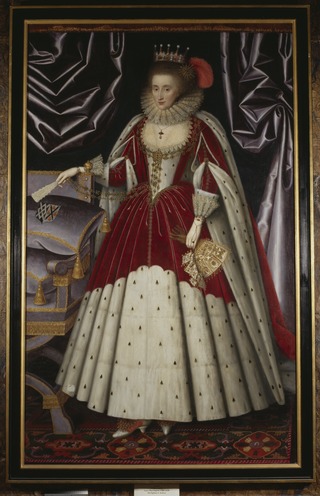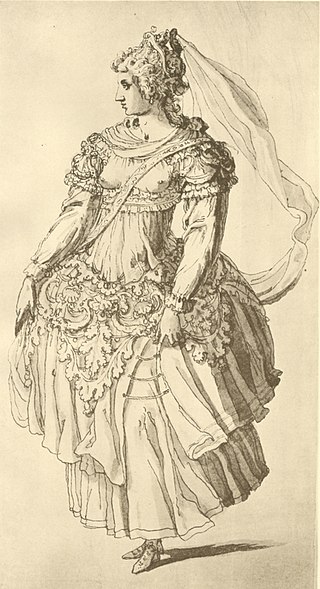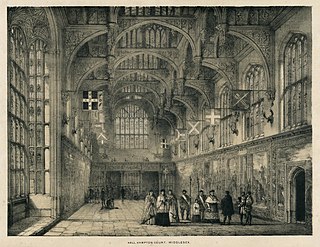Related Research Articles

The Masque of Blackness was an early Jacobean era masque, first performed at the Stuart Court in the Banqueting Hall of Whitehall Palace on Twelfth Night, 6 January 1605. It was written by Ben Jonson at the request of Anne of Denmark, the queen consort of King James I, who wished the masquers to be disguised as Africans. Anne was one of the performers in the masque along with her court ladies, all of whom appeared in blackface makeup. In a ceremony earlier on the day, Prince Charles, Anne's second son was given the title of Duke of York.

Margaret Stuart, Scottish aristocrat and courtier in England. She served as lady-in-waiting to the queen consort of England, Anne of Denmark. She was the daughter of James Stewart, 2nd Earl of Moray, and Elizabeth Stuart, 2nd Countess of Moray. The sailor and patron of Ben Jonson, Sir Frances Stuart was her brother.

Lucy Russell, Countess of Bedford was a major aristocratic patron of the arts and literature in the Elizabethan and Jacobean eras, the primary non-royal performer in contemporary court masques, a letter-writer, and a poet. She was an adventurer (shareholder) in the Somers Isles Company, investing in Bermuda, where Harrington Sound is named after her.

The Coronation Triumph is a Jacobean era literary work, usually classed as an "entertainment", written by Ben Jonson for the coronation of King James I and performed on 15 March 1604. The event was postponed due to plague in London.

The Vision of the Twelve Goddesses was an early Jacobean-era masque, written by Samuel Daniel and performed in the Great Hall of Hampton Court Palace on the evening of Sunday, 8 January 1604. One of the earliest of the Stuart Court masques, staged when the new dynasty had been in power less than a year and was closely engaged in peace negotiations with Spain, The Vision of the Twelve Goddesses stood as a precedent and a pattern for the many masques that followed during the next four decades.

Robert Spencer, 1st Baron Spencer of WormleightonKG was an English nobleman, peer, politician, landowner, and MP from the Spencer family.

Tethys' Festival was a masque produced on 5 June 1610 to celebrate the investiture of Prince Henry (1594–1612) as Prince of Wales.
Sir Edward Zouch of Woking was a courtier to English kings James and Charles I, a masque actor, and Knight Marshal of the King's Household.
Mary Middlemore was a Courtier and Maid of Honour to Anne of Denmark, subject of poems, and treasure hunter.
Elizabeth Roper was a member of the household of Anne of Denmark. She married Robert Mansell, a glass-making entrepreneur and became involved in his business. She was noted for her business activities as a "capitalist" by the historian Alice Clark.
Mary Gargrave was a courtier to Anne of Denmark.
Dorothy Hastings was a courtier to Elizabeth I of England and Anne of Denmark
John Wolfgang Rumler was a German physician and apothecary in Augsburg, known for his Observationes medicae, who eventually served the English royal family in the households of Prince of Wales, Queen Anne, King James and Charles I of England. He is also credited with making blackface theatrical grease-paint.

Prince Henry's Welcome at Winchester was a masque produced by Anne of Denmark and performed in 1603 at Winchester on a day between 11 and 17 October.

Anne Keilway, Lady Harington was an English courtier.

The Masque of Indian and China Knights was performed at Hampton Court in Richmond, England on 1 January 1604. The masque was not published, and no text survives. It was described in a letter written by Dudley Carleton. The historian Leeds Barroll prefers the title, Masque of the Orient Knights.

The wedding of Elizabeth Stuart (1596–1662), daughter of James VI and I, and Frederick V of the Palatinate (1596–1632) was celebrated in London in February 1613. There were fireworks, masques, tournaments, and a mock-sea battle or naumachia. Preparations involved the construction of a "Marriage room", a hall adjacent to the 1607 Banqueting House at Whitehall Palace. The events were described in various contemporary pamphlets and letters.
The Entertainment of the Two Kings of Great Britain and Denmark or The Hours was written by Ben Jonson and performed at Theobalds House on 24 July 1606. John Harington of Kelston described another masque of Solomon and Sheba, performed one day at Theobalds after dinner. There is some doubt over Harington's account. In May 1607 another masque An Entertainment of the King James and Queen Anne at Theobalds was performed when the keys of the house were given to Anne of Denmark.

The Masque of Owls at Kenilworth was written by Ben Jonson and performed at Kenilworth Castle on 19 August 1624 for Prince Charles.

Anne of Denmark (1574–1619) was the wife of James VI and I, King of Scotland, and King of England after the Union of Crowns. In 1617, she was depicted in a painting by Paul van Somer with an African servant holding her horse at Oatlands Palace. There are archival records of Africans or people of African descent, often called "Moors" or "Moirs", in her service. One of the first publications to mention Anne of Denmark's "Moir" servant in Scotland was edited by James Thomson Gibson-Craig in 1828.
References
- ↑ Martin Butler, The Stuart Court Masque and Political Culture (Cambridge, 2008), p. 360.
- ↑ Martin Wiggins & Catherine Richardson, British Drama, 1533-1642: 1603-1608, vol. 5 (Oxford, 2015), pp. 46-8.
- ↑ Karen Britland, 'Masques, courtly and provincial', Julie Sanders, Ben Jonson in Context (Cambridge, 2010), pp. 155-157.
- ↑ Susan Doran, From Tudor to Stewart: the regime change from Elizabeth I to James I (Oxford, 2024), pp. 121–122.
- ↑ John Nichols, Progresses of James the First, vol. 1 (London, 1828), p. 175.
- ↑ Lesley Lawson, Out of the Shadows: The Life of Lucy, Countess, Countess of Bedford (London: Hambledon, 2007), p. 50.
- ↑ John Nichols, Progresses of James the First, vol. 1 (London, 1828), p. 176 fn. 3.
- ↑ Martin Butler, The Stuart Court Masque and Political Culture (Cambridge, 2008), pp. 79–80.
- ↑ E. K. Chambers, The Elizabethan Stage, vol. 3 (Clarendon Press, Oxford, 1923), p. 391.
- ↑ John Nichols, Progresses of James the First, vol. 1 (London, 1828), pp. 180-3.
- ↑ Natália Pikli, Shakespeare’s Hobby-Horse and Early Modern Popular Culture (Routledge, 2022), pp. 80-3.
- ↑ John Nichols, Progresses of James the First, vol. 1 (London, 1828), pp. 174, 184-7, 189.
- ↑ Jessica L. Malay, Anne Clifford's Autobiographical Writing, 1590-1676 (Manchester, 2018), pp. 19-20.